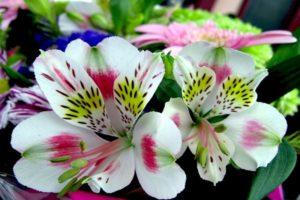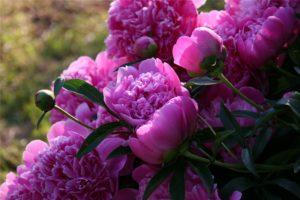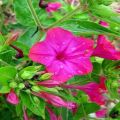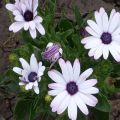Planting and caring for physical activity in the open field, a description of the 11 best varieties
Considering the rules of planting and caring for physostegia, it will be possible to enjoy lush and bright flowering for a long time. Each variety of an ornamental plant differs in terms of flowering, bush height, petal color. Cultivation begins with the preparation of the planting site and the processing of seed material. Reproduction is carried out in several ways. The flower looks beautiful in a flower bed with other plants.
Description and features
Physostegia virginskaya belongs to the group of herbaceous perennial plants of the Lipocephalus family. The name of the flower physostegia is translated from Greek as "bubble" and "cover".
The plant has the following features:
- height of a straight dense stem from 62 cm to 122 cm;
- powerful rhizomes, creeping type;
- flowers are arranged in pairs or opposite each other;
- the shape of the flowers is oblong or lanceolate, the petals are serrated at the edges;
- inflorescences form a long ear (its length is up to 32 cm) with a pleasant, sweetish aroma;
- most often there are snow-white, purple, pink or lilac colors of petals;
- flowering lasts from mid-July to the last days of September;
- after flowering, a ripe fruit remains in the form of a nut.
The virginiana flower does not have any special requirements, so every gardener will be able to grow it.
Popular varieties and types
In nature, there are more than 10 types of physostegia, but only one species is grown by gardeners - Virginia.
Alba
A strong triangular stem stretches up to 78 cm. Abundant flowering occurs in the last week of July. Large flowers are collected in a large ear and are distinguished by a snow-white shade.

Variegata
Variegata belongs to the variegated group of plants. The height of the bush reaches 87 cm. Elongated dark green leaves are distinguished by the presence of a white border around the edges. The flowers are deep pink.
Summer Snow
A perennial plant forms a bush 86 cm high. The inflorescences form a spike-like shape, their length exceeds 30 cm. Flowering lasts 1.5 months. The inflorescences are snow-white in color.
Summer Spire
The stem extends up to 88 cm.Flowers are arranged in an inflorescence in the form of an ear. The color of the petals is lilac-pink. The buds begin to bloom at the end of July.
Vivid
The height of the bush is average, reaching 65 cm. The leaves are oblong, dark green in color with a shiny surface. It begins to bloom in mid-July. The flowers are purple-pink, collected in inflorescences that resemble an ear.

Rose Bouquet
The plant forms spike-shaped inflorescences with large flowers of a rich pink color. The stem extends up to 122 cm in height.
Pink queen
A perennial plant forms a bush up to 68 cm high. Flowers of bright pink color enter into a long inflorescence in the form of an ear.
Crystal Peak
The erect, strong, tetrahedral stem grows to 78 cm. The flowering period coincides with the middle of summer. Flowers of snow-white color, collected in a long spike.
Miss Manners
The height of the bush reaches 56 cm. The leaves are oblong, narrow. Inflorescences are snow-white, up to 23 cm long.
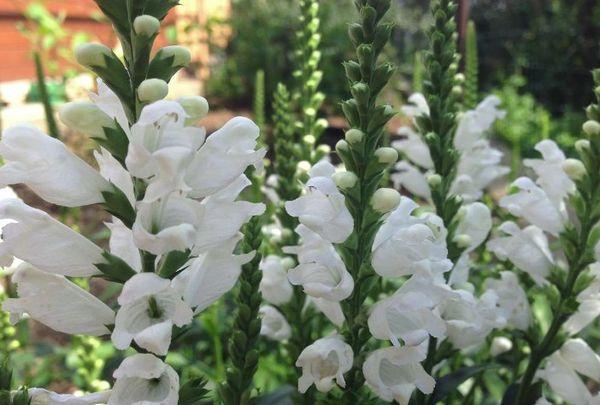
Shining summer
The variety is distinguished by tall bushes, the stem stretches up to 125 cm in height. Flowers of a bright lavender-pink color are collected in an ear.
Variegated
This type of physostegia is distinguished by dark green leaves with a white border around the edges. The flowers are pink-lilac.
How to grow
To grow seedlings of physostegy at home, you should prepare seeds, choose suitable containers and soil.
Seed and container preparation
Flower seeds sprout well. To improve their quality, they must first be processed. The seeds are immersed in a solution of potassium permanganate, and then soaked in preparations that stimulate growth.

Seeds are sown in special containers for seedlings. There must be holes at the bottom of the container. Better to carry out seeding in separate cassette cups. Three seeds are placed in each glass. In this case, it is more likely that the shoots will be strong and thinning will not be required.
Soil preparation
The boxes are covered with nutritious soil. The soil should be nutritious, light, with neutral acidity and good aeration. It is best to buy a general purpose primer in the store.
Timing
Seeds for seedlings begin to be sown in early March. In two months, it will be possible to start transplanting to the summer cottage.
Growing seedlings
Strong plants can only be obtained if the seedlings are grown correctly:
- They make grooves 6 mm deep, sow seeds, cover them with earth and moisten.
- After that, the container is covered with foil and removed to a warm, bright place.
- The first shoots should appear after 12 days.
- Before the first shoots appear, the film is periodically removed from the box for airing.
- As soon as most of the seedlings appear, the film is removed.
Young shoots should be protected from direct sunlight and drafts. Water the seedlings as the top layer of the soil dries. After watering, you need to loosen the soil. After the appearance of the first pair of leaves, the planting is thinned out, leaving a distance between the shoots of 8 cm.
Picking
After unfolding the second pair of real leaves, they begin to pick in a larger container. The distance between the shoots is 9 cm.
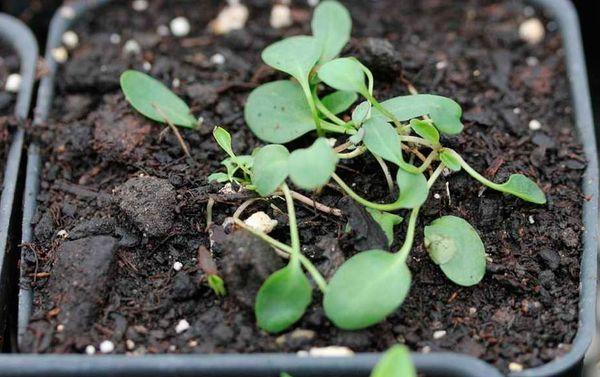
Hardening
12 days before transplanting seedlings to open areas, they begin the hardening procedure. For this purpose, the seedlings are taken outside every day. The time spent in the air should be increased gradually, starting from 10-15 minutes.
Landing in open ground
Physostegia refers to unpretentious plants. Suitable for planting in a sunny or partially shaded place. But if no light falls on the site during the day, the flowers will be small and faded.
The soil should be fertile, light and moist, with a low level of acidity. The ideal option is loamy, sandy loam soil.
What time to plant
Prepared seedlings begin to be planted in an open area in the last days of May, when the threat of frost return will be minimal.
Landing scheme
The soil in the selected area is dug up in advance and fertilized. Then make holes at a distance of 27 cm. Since the root system of the flower is powerful and creeping, it is necessary to take measures to limit their growth. Otherwise, it will not be possible to grow other flowers near physostegia:
- Experienced gardeners recommend planting each bush in separate containers. For example, they take an old bucket, remove the bottom and dig it into the ground and plant a bush.
- Another option is to dig a slate, wooden board or metal plate around the flower bed to a depth of 38 cm.
You should regularly pull out the extra bushes of the plant along with the roots.
Care
With proper care, flowers will delight with beautiful flowering.
Watering
Physostegia needs systematic moderate watering. The procedure is carried out in the morning. For irrigation, take warm, settled water:
- In hot weather, physostegia should be irrigated every two days.
- On rainy days, additional soil moisture should be stopped.
Loosening and weeding
After watering, it is imperative to loosen the soil while simultaneously removing weeds:
- Loosening will prevent dry crust from forming on the ground. In addition, air and nutrients will freely penetrate to the root of the plant.
- Weeds must not be allowed to grow. It promotes the development of fungal diseases and increases the risk of insect pests.
Mulching
Flower care will be easier if you mulch the soil. Peat or humus is suitable as mulch. Mulching will significantly reduce the number of waterings and reduce weeds.

Top dressing
In the case of planting physostegy in fertile soil, feeding is carried out once for the entire season. It is best to use mineral-based liquid solutions. The procedure is best done before flowering.
Protection from pests and diseases
The flower is highly resistant to infections and pests. But sometimes problems can appear.
Most often, physostegy is attacked by aphids. The insect sucks out all the juices from the plant, as a result, it withers, turns yellow, drops the buds. Such preparations as "Aktara", "Actellik" will help in the fight against pests.
Physostegia suffers from rust or fungal infections:
- Rust is easy to recognize. The leaves and stem are covered with yellow-brown raised spots of various sizes. Gradually, the leaves curl, turn yellow, dry out, the buds fall off. Such drugs as "Altazol", "Topaz", "Baktofit", "Atlant" will help to fight the disease.
- A fungal disease, powdery mildew, can be recognized by a whitish bloom on the leaves and brown spots. Leaves gradually dry up, buds and flowers fall off, plant growth stops. Such funds as "Hom", "Topaz", "Oxyhom", Bordeaux liquid come to the rescue.
- Gray rot develops in a rainy summer. A gray bloom appears on the stem in the root zone. Then the disease spreads to leaves and inflorescences. When the first signs of the disease are found, the bushes are treated with "Topsin", "Fitosporin".
- If the rules of care are violated, there is a high probability of root rot. The leaves of the plant are deformed, wither, dry.
Preparing for winter
Physostegia tolerates low air temperatures well. But in regions with cold winters, you still need to cover the bushes with straw, sawdust, fallen leaves, peat or pine branches. The bushes are pre-cut, leaving a height of 27 cm.

Reproduction
Reproduction of physostegia is carried out by seeds, layering, dividing rhizomes or bush and cuttings.Each method has its own distinctive features.
Seeds
Physostegia is often grown through seedlings. For two months, the seeds are germinated at home, and then transplanted into open areas.
After ripening, the seeds themselves can spill out of the fruit onto the ground, and in the spring they begin to germinate. Then it will be enough just to place them in the right place.
Rhizome division
In the autumn months, before the onset of frost, the root part is divided. The bush is dug out of the ground, divided into separate parts and planted in a permanent place.
Dividing the bush
This breeding method is most often carried out in the spring, before the beginning of the budding period. It is allowed to share the bush at the end of summer, after the end of flowering. The bush is dug out of the ground, the ground part is cut off. Then it is divided into several parts. Each separated part is planted in the same way as the seedlings.
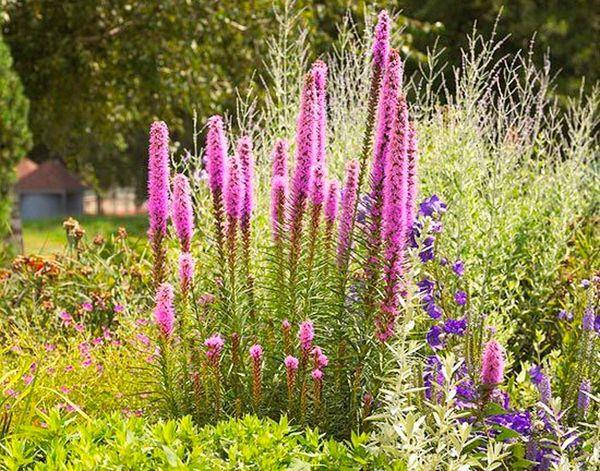
Layers
The bush of physostegy is bent to the ground. They are pressed with a bracket and covered with earth. As soon as rooting occurs, the layers are dug up and transplanted into a shaded place. Layers are transplanted to a permanent place in a year, when the plant grows up.
Cuttings
Cuttings are cut from the bush in April, before flowering:
- The length of each branch should be 11 cm, 2-3 buds must be left on it.
- Then the cuttings are planted in a container of wet sand and removed to a dark, cool place.
- The next spring, the cuttings are transplanted into the ground at the site.
- It will be possible to transplant the cuttings to a permanent place only after another year.
Transfer to a new location
Growing in one place is permissible for 4 years. Then a transplant is required in order to maintain a spectacular, bright appearance. The bush is dug out of the ground, divided into several parts and planted in a new place. The transplanted bush needs regular watering, so it is immediately recommended to mulch the soil.
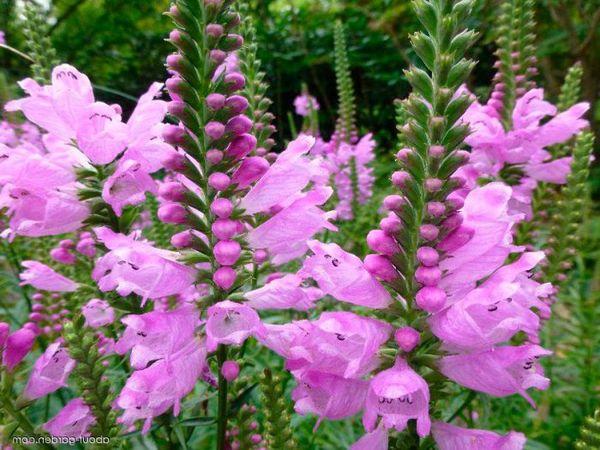
Collection and storage of seeds
Seeds begin to ripen in late August. Since they are easily carried by the wind, it is better to collect the material long before the final ripening. Ripe seeds are black in color.
The collected seeds should be thoroughly dried, placed in cloth bags and stored in a dry, dark place.
Use in landscape design
Physostegy looks beautiful with other perennial flowers. In the garden, flowers are best planted along a fence or path. Physiostegy bushes look beautiful around an artificial pond or fountain.
